IN THIS ISSUE
- Check the checkoff
- Gator bunking in a burrow
- Rubythroats' wide-ranging diet
- Wanted: Leads in eagle shooting
 Checkoff beneficiaries: big brown bats, smooth coneflower (Pete Pattavina/USFWS, Natalie Birnbaum/GNPA)
Before you complete your Georgia income tax form, please do three things.
One, find the Georgia Wildlife Conservation Fund checkoff (line 31 on Form 500 or line 10 on Form 500EZ).
Two, consider contributing: All donations matter.
And three? Realize that by giving you are helping conserve Georgia wildlife that aren’t legally hunted or fished for – about 95 percent of our native species – plus rare plants and the wildlands these plants and animals need.
That work is led by DNR’s Wildlife Conservation Section, which depends primarily on grants, donations and contributions. Contributions like yours.
DID YOU KNOW
- Checkoff contributions to Georgia’s Nongame Wildlife Conservation and Habitat Acquisition Fund – that’s the full name – made up 8 percent of fund revenues in fiscal year 2022.
- In 1989, state lawmakers approved what has been called the Give Wildlife a Chance checkoff to benefit everything from gopher tortoises to cerulean warblers and smooth coneflowers.
- That same year legislators created the Nongame Wildlife Conservation Fund, which is dedicated by law to conserving nongame, acquiring habitat and informing people of the work and the need.
 Tattnall County gator basking beside its borrowed gopher tortoise burrow. (Matt Moore/DNR)
A gator walked into a burrow. …
Well, this actually isn’t a joke. And the fact that an alligator did walk, or squeeze, into a Tattnall County gopher tortoise burrow for three winters in a row and over 800 yards from the nearest wetland makes it more fascinating than funny, according to DNR wildlife technician Matt Moore.
“This gator is traveling long distances just to spend the winter in a tortoise burrow each year,” Moore said.
Gopher tortoises are a keystone species mainly because the long, deep burrows they dig also benefit about 350 other animals. American alligators aren’t usually on that list. But the past three winters while surveying for rare eastern indigo snakes on private land in Tattnall, Moore and fellow technician Andy Day have discovered a gator in a tortoise burrow.
As Moore said, showing a talent for understatement, “When we get on our belly to look down a gopher tortoise hole, to see a 4-and-a-half foot alligator’s big smiling face looking back at you is a surprise.”
The surprise greeted them at the same burrow the last two years and at a nearby one in 2021. Moore and Day think it's probably the same gator. They set up a camera to document the use this year and even walked up on the gator sunning by the burrow.
The big reptile didn’t dive for the hole, and even seemed reluctant to go in, Moore said. “That made us think he kind of slides (in) backward.” Makes sense: For an animal almost 5 feet long, turning around in a tortoise tunnel could be trouble.
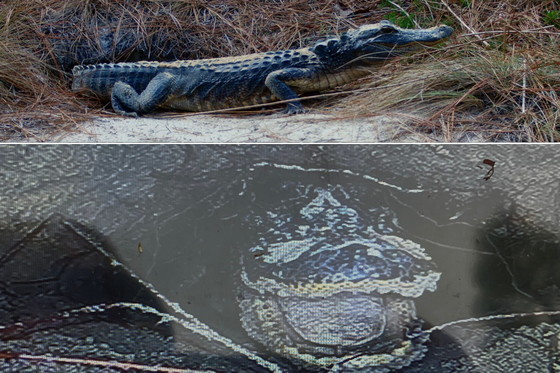 At the tortoise burrow entrance (top) and inside (DNR)
What’s puzzling is why this alligator travels so far to use this refuge. Gators often winter in dens or holes along waterways. But the burrow is farther than eight football fields from a significant water source. In between is rugged, fire-suppressed sandhills scrub, plus other tortoise burrows that are closer, Moore said.
“There must be some level of memory involved. He can’t be following (last year's) scent trail. I can only assume he’s remembering that’s the place to go.”
Alligators have been spotted in gopher burrows at least twice before in Georgia (Day found one of them). Yet both were near wetlands. And neither involved a burrow used multiple years.
Moore took detailed photos of the alligator last month to help identify the animal if it’s spotted again. He also plans to check the tortoise burrow this summer to see if gophers are crawling in when the gator is gone.
“It’s still a work in progress in certain respects to fully understand what’s going on with this burrow.”
Or with this gator. “We want to see how long this goes on," Moore added. "Eventually he’s going to outgrow the burrow.”
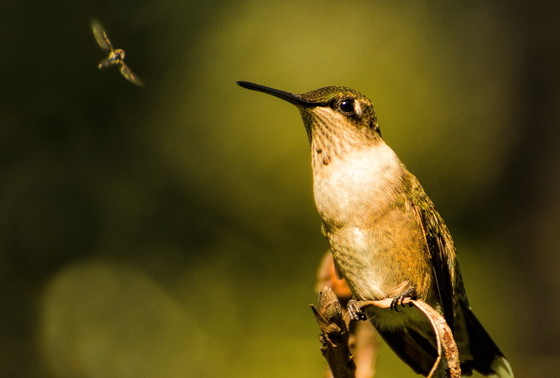 Ruby-throated hummingbird eyes an insect (Diane Yancey/GNPA)
By TERRY W. JOHNSON
Through spring and summer, we Georgians spend a lot of time watching ruby-throated hummingbirds eating at our feeders and flowers.
Their visits are so frequent you might think the food we’re providing is all they need to survive.
But the truth is that hummingbirds require far more than the sugar in our feeders and the nectar of flowers to prosper. …
From insects to fruit juice, learn how your yard can better feed rubythroats.
Terry W. Johnson is a retired DNR manager and executive director of TERN, friends group of the Wildlife Conservation Section. Check out past columns and his blog. Permission is required to reprint a column.
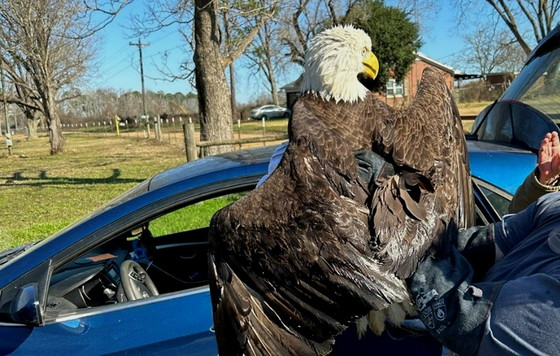 Wildlife rehabilitator with the injured eagle (John Kennedy/DNR)
The public’s help is needed to find out who shot a bald eagle in Irwin County. State and federal agents said they are still looking for leads in the case, which resulted in the adult male eagle being euthanized.
With this crime, as with most, the victim wasn’t the only one that suffered.
DNR Game Warden 1st Class John Kennedy answered the Jan. 9 call from a landowner who spotted the injured eagle by a pond along Ponderosa Road, just west of Ocilla and near Alapaha River Wildlife Management Area. As the bird was being captured and checked, Kennedy said another eagle watched nearby.
“She was there the whole time … in the top of a cypress tree.”
DNR Program Manager Dr. Bob Sargent said it’s possible the two eagles were mates “given that they were both adults, reportedly of different genders and this was within nesting season.” In general, bald eagles mate for life.
Whether this pair had young is not known. Sargent, who conducts DNR's bald eagle nesting surveys, explained that both adults being off the nest in early January in that part of Georgia would be rare unless they nested early and their eaglets were 3 weeks or older. The young can thermoregulate at that age and survive a brief stay alone.
However, if the pair did have eaglets – the average in Georgia is two per nest – keeping up with feeding them “will be tough for one adult,” Sargent said.
The male eagle was shot with what looks like buckshot. A radiograph revealed that one pellet broke the right humerus, or upper wing bone. Others peppered the bird’s body. The back side of the broken wing also was infected.
A veterinarian who viewed the radiograph assessed the damage as “not fixable,” said Josh Rousey, practice manager at Quailwood Animal Hospital in Tifton.
A reward is offered for information that leads to an arrest. Contact DNR (800-241-4113 or rangerhotline@dnr.ga.gov) or the U.S. Fish and Wildlife Service at (404) 679-4000.
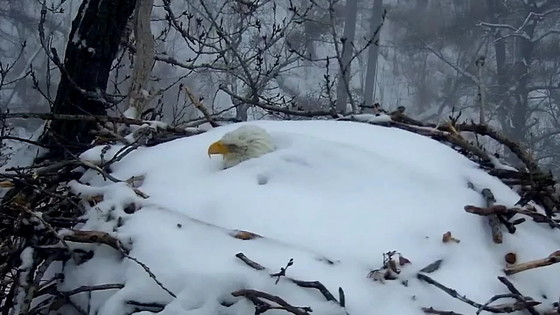 Nesting eagle snowed in at Minnesota nest (Minnesota DNR)
BIRDS IN BAD WEATHER
A storm system that swept through Georgia this month destroyed a bald eagle nest near Lafayette, killing two eaglets, and reportedly blew another eaglet to its death at Lake Nottely, DNR’s Dr. Bob Sargent said. The high winds also toppled trees near the livestreamed nest at Berry College but the nest and its eaglet escaped unscathed.
In Minnesota, a February storm dumped smothering snow on a bald eagle and her two eggs. The mom weathered the blow – watch this time-lapse video – and kept protecting the eggs. Although one egg has since been documented as broken, the adults are incubating the other.
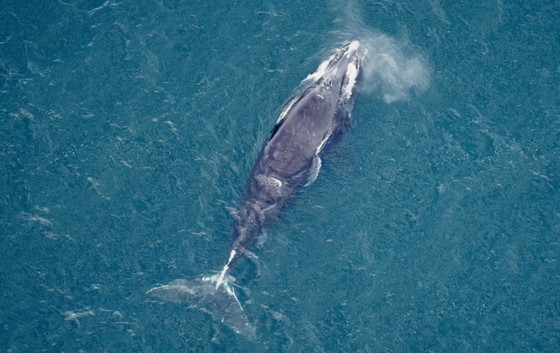 Right whale Nimbus gear-free near Martha's Vineyard (New England Aquarium/NOAA permit 25739)
Good news on Nimbus! The North Atlantic right whale that was dragging 375 feet of thick fishing rope until DNR and partners cut most of it away in January was seen this month near Martha’s Vineyard in Massachusetts. New England Aquarium photos also show that the 15-year-old male has shed a short rope segment the disentanglement crew couldn’t remove but thought would come loose. Entanglement in commercial fishing gear is the leading cause of death and injury for North Atlantic right whales, one of the world’s rarest large whales.
Bats in the belfry? Remember to avoid excluding bats from buildings April 1-July 31, when bat pups are too young to fly and can be trapped inside and die. Exclusions required during this maternity period must be done by a licensed nuisance wildlife control operator.
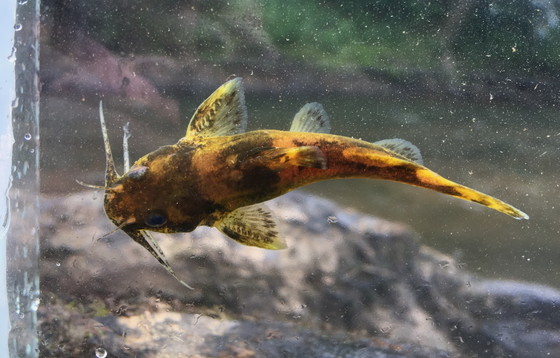 Frecklebelly madtom, an increasingly rare catfish (Brett Albanese/DNR)
The federal listing of frecklebelly madtom as threatened in the upper Coosa River basin is being finalized, along with designating critical habitat in Georgia along parts of the Conasauga and Etowah rivers. A “distinct population segment” of the small, native catfish is at risk of becoming endangered, largely because of poor water quality caused by development and agricultural practices.
Eight lake sturgeon were recently collected, fitted with radio tags and released on a Coosawattee River stretch considered prime spawning habitat for the ancient species. One of the fish, a mature female, weighed 26.6 pounds, the largest recorded since DNR began reintroducing lake sturgeon more than 20 years ago.
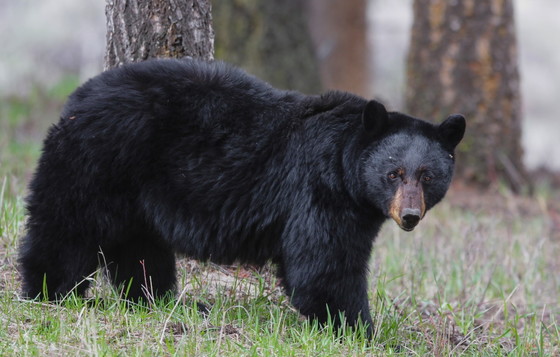 BearWise offers information for co-existing with black bears. (DNR)
Are you BearWise in the wild and around the house? Learn how to live responsibly where black bears are found – as well as what the bruins are doing during March – at BearWise.
A two-centuries-old clam nicknamed Aber-clam Lincoln (according to calculations, it was born in 1809, the same year as Lincoln) made headlines and even "SNL." A skit on the late-night comedy joked about the 2.6-pound ocean quahog found by an AmeriCorps member and returned to the Gulf of Mexico.
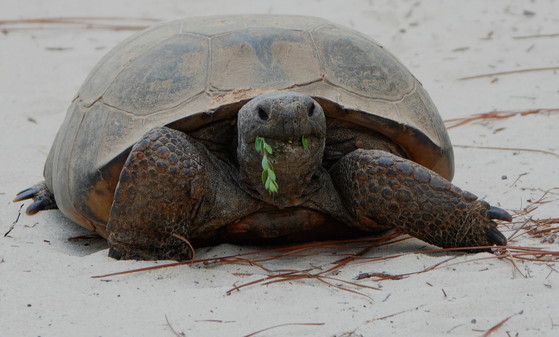 Gopher Tortoise Day is coming April 10. (DNR)
Quick hits:
Names in the news: Country music star Chris Janson and Athens-born band The Tuten Brothers usher in the new Georgia Natural Resources Foundation fundraiser A Night for Wildlife on April 27 at Atlanta’s Buckhead Theatre. Dr. Nicole Nemeth of the UGA College of Veterinary Medicine was lead author and worked with co-authors including DNR’s Dr. Bob Sargent on recently published research exploring the impact of highly pathogenic avian influenza on nesting bald eagles in the Southeast. Linda May, outreach coordinator for DNR’s Wildlife Conservation Section, and Grace Manning, Trees Atlanta Beltline arboretum manager, will discuss the importance of healthy urban forests and wildlife corridors at What’s Happening on the Beltline March 27 at Trees Atlanta Kendeda Treehouse in Atlanta. (Admission is free but preregistration is required.) DNR Game Warden 1st Class Greg Castelli, assigned to Lake Harding in west Georgia, received the International Association of Marine Investigators’ Investigator of the Year Award.
"Ask a Biologist" series: DNR senior biologist Clay George answers North Atlantic right whale questions
Michigan DNR reviews Cocaine Bear movie trailer
Peregrine falcons mating in Atlanta, DNR
"Conserve Georgia grants awarded for conservation, outdoor recreation," DNR
"Rare catfish federally protected in Tenn., Ga.," WZTV-TV (ch. 9, Nashville, Tenn.)
"Bald eagles aren’t fledging as many chicks due to avian influenza," UGA Today. Also: Atlanta Journal-Constitution, USA Today.
"The volunteers behind the Savannah nest cam," Savannah Morning News
"Ossoff, Carter push for Okefenokee UNESCO listing," WABE-FM (90.1, Atlanta) Related: "Carter will be irreplaceable," Georgia Recorder.
"Zoo Atlanta welcomes endangered bog turtle hatchlings," WAGA-TV (ch. 5, Atlanta) and others (Zoo Atlanta release)
"Will Bartow wildlife preserve stay wild or be developed?" The Atlanta Journal-Constitution
"DNR biologist: do’s and don’ts for feeding birds," WSAV-TV (ch. 3, Savannah)
"Why 23 dead whales washed up on East Coast since December," The New York Times. Also: "Unraveling the causes" (YaleEnvironment360).
"Hundreds of boats sped in protected areas for right whales," FOX News
"DNR Youth Birding Competition returns to its roots," EIN Newswires
"Protecting Florida's savannas, ranchlands before it's too late," U.S. Fish and Wildlife Service
"How fire earns good marks in the forest," Classic City News
"Wild cam: When humans are away, Glacier wildlife strays," The Wildlife Society
"Cougar swims Puget Sound, makes splash with scientists," Atlas Obscura
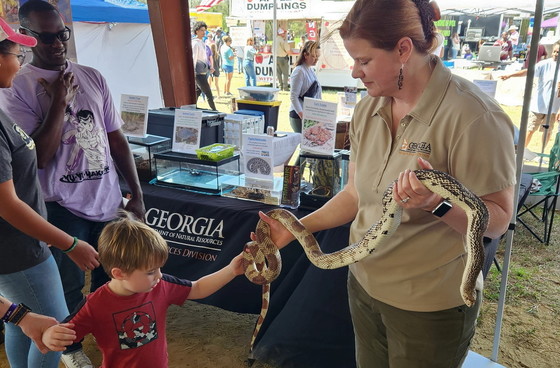 DNR’s Linda May shows a pine snake to some of the 6,000-plus visitors at the Whigham Rattlesnake Roundup March 4. Both Georgia rattler fests – including the Claxton Rattlesnake and Wildlife Festival held March 11-12 in Hagan – are no-kill events. The conservation format has helped bolster turnout and inform the public without hunting or harming wild snakes. (Photo: Daniel Sollenberger/DNR)
Top
|